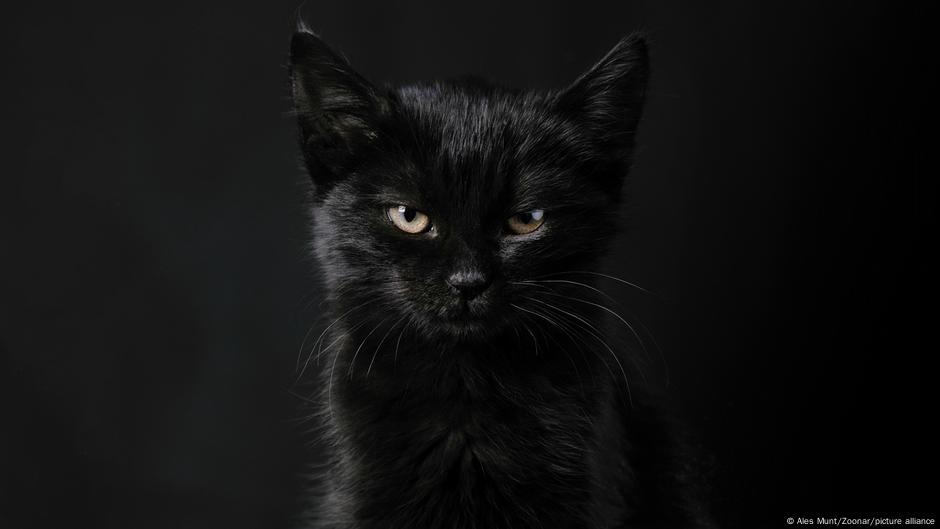It’s the darkest time of the year. You are walking outside, the sun has already set. Suddenly, out of the shadows, a black cat comes your way. If you are superstitious, you can easily step back – after all, black cats are seen by many as a sign of impending bad luck, especially if the cat moves from left to right.
With their piercing eyes, dark shiny coats and graceful, secretive gait, black cats have a sense of mystery about them. In many cultures, they are symbols of the supernatural.
As Halloween approaches – the October 31st celebration that’s all about horror – these dark creatures are appearing everywhere, as decorations, in movies, and in costumes. But how did the black cat become such a symbol of horror?
From witches’ companion to halloween staple
Their dark reputation dates back to the Middle Ages, when they served as scapegoats, victims of the fear of evil themselves. During the witch hunts, people believed that black cats were actually witches who disguised themselves at night to spread bad luck. Considered creatures of the devil, they were often burned along with alleged witches. Many old paintings and drawings depict witches with black cats at their sides.
By the 18th century, in some parts of France, thirteen black cats were burned alive in bonfires on the occasion of the summer solstice. French journalist Jean-Louis Hue writes in his book on cats that in Ypres, Belgium, they were thrown from a church tower.
The first European immigrants took their superstitions with them. During the 19th century, Halloween was becoming a popular folk festival in the United States, and the black cat was establishing itself as an important part of this tradition. It still appears on Halloween greeting cards, graves and pumpkins today – black as night, with an arched back and glowing, mysterious eyes.
black cat brings good luck
However, not everyone views the black cat as a bearer of bad luck. In the UK and Ireland, a black cat crossing a path or entering a house brings good luck. In Scotland, a black cat on your doorstep is a sign of coming prosperity.
In Japan, black cats, in addition to being a symbol of luck and wealth, also protect against bad health. The traditional Japanese “maneki-neko” or “beaking cat” also comes in black and is believed to ward off demons. It is also said that a woman who owns a black cat has good luck in attracting men.
Black cats were also popular on ships. They were seen as good omens, keeping storms away and ensuring safe return – not to mention that they kept ships free of rats and mice.
In ancient Egypt, the goddess Bastet was worshiped as the protector of pregnant women, mothers, and children. She was also a patron of joy, music and dance. Early depictions show her as a woman with the head of a cat; Later he was often depicted solely as a cat. Of course, she was always black.
Why are black cats actually black?
According to a legend, God created the black cat before he created the crow, so he got the purest batch of black paint. Of course, those black coats are not the result of divine intervention or magic, but of genetics.
What is known as the “B” gene in cats begins to produce the eumelanin pigment, which gives their fur and often their nose and paws their dark color.
Most black cats are male. This is because the B gene is found on the
Between Poe and pop culture
Black cats have a long heritage in art and culture. In 1843, Edgar Allan Poe dedicated to her a chilling short story, “The Black Cat”, a tale of murder and madness.
The black cat later became a symbol of cool, independence, and rebellion in pop culture. In the American TV series “Sabrina the Teenage Witch” (1996), a sarcastically quippy cat named Salem became a crowd favorite.
In the anime series Sailor Moon, Luna, a talking black cat with a crescent moon on her forehead, serves as a mentor and protector to the heroes, symbolizing female intuition and wisdom.
Black cats form part of film director Tim Burton’s distinctive visual language in films like “The Nightmare Before Christmas” and “Corpse Bride,” as beautiful as they are sad.
After the success of the superhero film “Black Panther” (2018), many people adopted black cats and named them after characters from the film, such as T’Challa or Shuri.
In rock and goth culture, the black cat symbolizes individuality, mysterious allure, elegance, isolation and pride.
As Halloween approaches, remembering all the meanings of black cats and all the qualities they can hold helps us see them not just as symbols of fear, but for what they really are: elegant, mysterious, independent – and maybe a little bit magical.
This article has been translated from German.





Leave a Reply